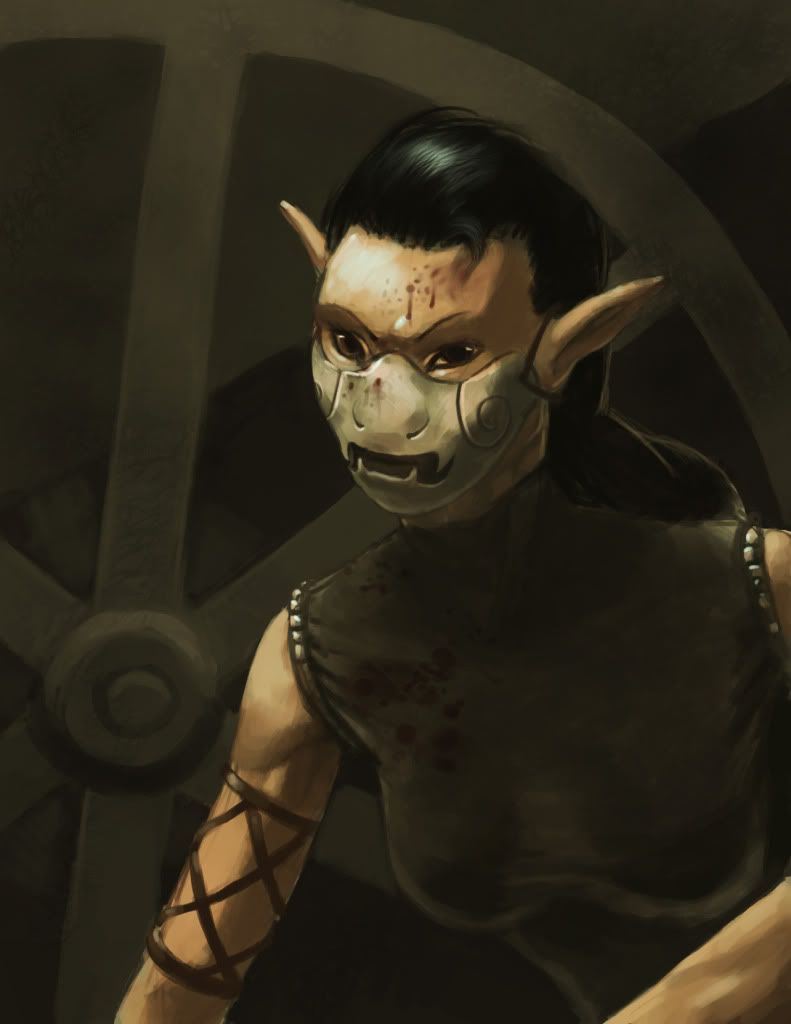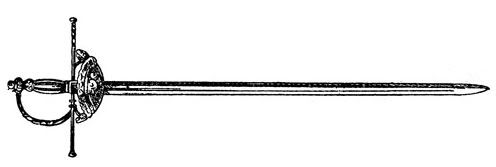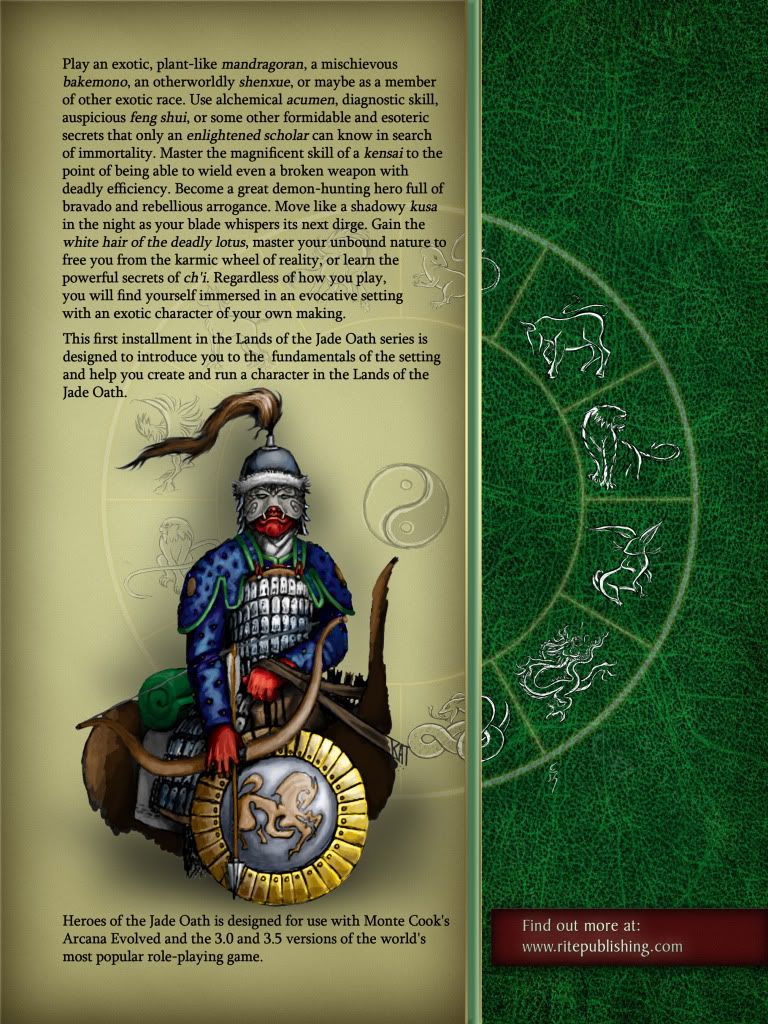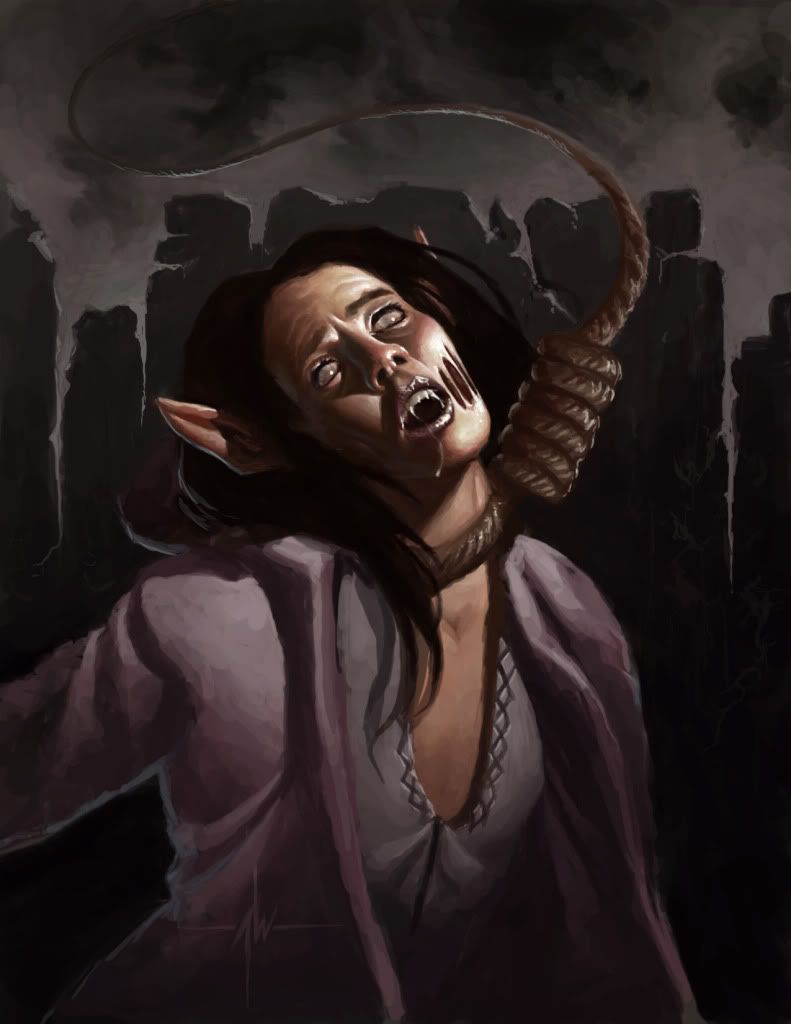Welcome to Fridays & Functions; a series of a posts that will always deal with what goes on behind the scenes, including design diaries, interviews, technical commentary, etc. First up is a 6 part interview with Frank Carr Author of Heroes of the Jade Oath you can find
Part 1 Here , Part 2 Here Part 3 Here Part 4 Here; Be on the look out for the Preorder Print and PDF bundle to be available soon at Paizo.com
41. How did you feel when you saw the layout for the first preview? What were you impressions of Corey Graham’s work?
I thought Corey did a great job with the layout, especially the fonts and that beautiful border; which by the way actually says, “Lands of the Jade Oath” in Chinese and is not just a literal translation, but it is a contxtually correct usage of the words for the title.

42. Quickling Pirate Ninjas?
Huh? Where?! They've been after me ever since that time when I almost didn't consider them for the indigenous race of Javasriya.
43. How do you feel about lands of the jade oath as a patronage project rather than a traditional model? Would you have preferred something else like the Ransom Model?
I think that the patronage project model may have been the only real way to do this project justice and get it done right for those who have been wanting to see this setting for so long. I don't think any other method would have allowed this setting to get done right.
44. What are your recommendations for making Lands of the Jade Oath relevant in a n existing campaign (AE game, 3.5 game and/or hybrid)?
If you don't already have an existing area for the orient to your campaign, then Jade Oath might be a good setting to consider if your players should decide to explore that region. Also, some of your players might want to come from this region even if you don't actively play in the setting; they can use the information from Jade Oath as part of their character background – maybe even having enemies from their past hunting them down. As far as game mechanics, you should consider using Arcana Evolved as that is the default Player's Handbook for the Jade Oath setting. It is designed to be used with the AD&D 3rd edition Player's Handbook as well. Hybrid campaigns might work the best, but using the setting with just AE is also just fine.
45. How did magic and the supernatural affect the cultural and ecological evolution of Lands of the Jade Oath?
Culturally, the wu lin societies that are already in place in a lot of Asian fiction was ideally the way to go. It was already there and established for powerful warriors and workers of magical deeds. I just extended it to be a useful type of institution throughout the setting. Ecologically, there are many magical locales such as the Ghostwall, City of Dragon's Sacrifice, Broken Pillar, mist-trees, the Islands of Mu, the Hidden City, the Valley of Jars, floating mountains, City with No Name, and other various mystical sites that can be explored and many even have a very real basis in the real-life equivalent nations in Asia, such as the Great Wall of China (Ghostwall) and the Valley of Jars (the Plain of Jars in Laos).
46. Could you talk about your favorite new race from Lands of the Jade Oath?
I don't know what to say; I like them all. It's like asking me to pick a favorite child. Well, looking at most of them, they are derivative of other fantasy races that we have seen at one time or another. Sanesaram are dwarves, yueren are elves, qahngol are half-orcs, and hushen are a subrace of litorians. So, I guess out of those that I think are not quite so derivative, that leaves the shenxue, mandragoran, and bakemono.
I like the shenxue a lot due to their inherent connection to nature and the spirit world. They are also very interesting from a design perspective as well and was perhaps the hardest and most time-intensive race to create for me. No two shenxue are alike and I think that is a great part of what appeals to me about them. I like that they can be connected to both another standard PC race and yet also be connected intrinsically with a natural part of the world or one of its elements.
Bakemono are like the mischievous little bastards you hate to like in certain movies. They are part goblin, part kappa, part Loki, part Yoda, part Oghra from the Dark Crystal, and part Gremlins with a good chunk of mythological bakemono attitude and stereotypical harridan thrown in for the women of the race. They are the evil muppets of the Jade Oath setting and I can't help but love them for their inherently mischievous nature. It's just too delicious a way to have fun to pass up when creating a character.
The Mandragorans are perhaps the oldest race on a purely creative level with me personally. I first created what would become the mandragorans back in 1994 as a mercantile race for my 2nd edition AD&D game. They were a fusion of a comic book I had seen of a character with a head-tail from Micronauts back in the 80's, Twi'leks from Star Wars (the Micronaut and Star Wars inspirations were for the initial ideas to incorporate head-tails on the race), Obsidimen from Earthdawn (for the idea of colorful “veins” running across their bodies), Pitt and Nautica characters from what was back then Image Comics (for the lack of a nose), and the attitude of a race from Talislanta called the Ispasians (who also had no nose). Eventually, they evolved to incorporate inspiration from Farscape ( Zaan, the blue plant lady, and Dargo, the guy with the bird-beak nose and the head-tails.), some more original ideas I had wherein I thought about giving them several aspects from Indian culture fused with ideas I had on Druid-like plant people. Then I gave a lot of thought to their physiology, which evolved to what it is now after talking with an artist how plant-like head-vines should look with a more irregular and asymmetrical design.
47. What is your favorite new class from Lands of the Jade Oath?
Man, that is a hard thing to say. I like them all. The kensai is pretty much the way I think a warrior dedicated to lifelong mastery of a single weapon should be. The kusa is my ideal and most flexible vision of the ninja. The demon hunter is built with subclasses to take advantage of the different ways one can specialize in fighting demons and other infernals, while being a tough combatant with a little magic at his disposal. The enlightened scholar is very flexible with a lot of different ways to interpret him.
Right now, if I had to pick one I guess it would be the enlightened scholar. I just love that, even more so than any other new class in the book, he covers an archetype that doesn't ever really get covered well in the rest of D&D or AE – the martial physican, the mad scientist, the adademic field scholar who doesn't know magic, the alchemist who doesn't work with spells, the peasant mage, the fang shih, the crazy inventor (and let's face it – ancient China had a lot of these between alchemists seeking immortality who consumed mercury, crushed dinosaur bones, and cinnabar and then there were guys like the one that strapped fireworks to a chair in order to achieve flight – that didn't end well), etc. This archetype is perfect for characters like that of Uncle from Jackie Chan Adventures, Fong Sai Yuk, Kang the Mad from Jade Empire, Johnny Depps version of Ichabod Krane from Sleepy Hollow, Q from James Bond, the Professor from Gilligans Island, and Fester from the Addams Family, etc.
48. How did your relationship with Rite Publishing start? How would you characterize it now?
It started at GenCon last year when I played in a sort of playtest game for A Witches Choice with Steve Russell and Bill Collins amongst others. We had some time prior to the game starting while Steve set up the game and we waited for other players to show up. Steve had questions about the progress of Jade Oath, so we talked about it. As we talked, Steve pitched the idea of me trying to get it published under the Patronage business model that Steve had recently come from a seminar on. Eventually the conversation led us down the path of Steve doing the publishing for us and I told Steve very early on that I wanted Bill Collins as my editor, which he agreed with me about for many reasons and now we are all making this great product with lots of other nice and talented folks. I think we all get along pretty good. If anyone ever rocks the boat it is usually my fault because I can be unreasonably demanding, tyrannical, and puritanical about my vision for the product. The guys at Rite Publishing are super understanding though and put up with my tirades quite well. ;)
49. What makes a good Oriental Rpg product?
I think a good oriental RPG product needs to not just be grounded in historical facts, but it should also emphasize the fantasy of a mythological Asia as well as incorporate some new and original ideas that are derived from the philosophies and mythologies of Asia. After all, the best western fantasy games have taken that path with regards to Western cultures and it seems to have worked out really well for them.
It should also be well rounded. By that, I mean that it should consider a lot of, if not all, of the major cultures of Asia. They are all so rich in culture and mythology that I think it is a shame to ignore any of them. A good oriental setting shouldn't have its most influential culture or kingdom exist in a vacuum. It should be surrounded by other kingdoms and cultures that it influences and is influenced by and these cultures should be reasonably well described for the setting as well as being considered when creating races, classes, equipment, etc.
50. What is your favorite Oriental Rpg product (besides yours)?
Well, it is hard for me to pick any single one, but I suppose I could say that I really like Cathay: Jewel of the East by AEG, Mystic China by Palladium Books, the Kara Tur box set by TSR, and Dragonfist by Chris Pramas and TSR.






